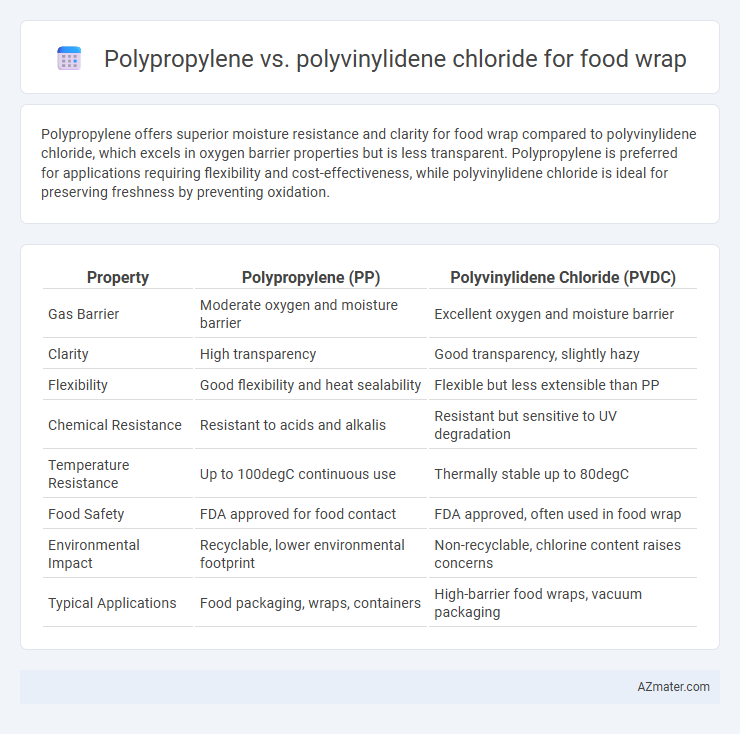Polypropylene offers superior moisture resistance and clarity for food wrap compared to polyvinylidene chloride, which excels in oxygen barrier properties but is less transparent. Polypropylene is preferred for applications requiring flexibility and cost-effectiveness, while polyvinylidene chloride is ideal for preserving freshness by preventing oxidation.
Table of Comparison
| Property | Polypropylene (PP) | Polyvinylidene Chloride (PVDC) |
|---|---|---|
| Gas Barrier | Moderate oxygen and moisture barrier | Excellent oxygen and moisture barrier |
| Clarity | High transparency | Good transparency, slightly hazy |
| Flexibility | Good flexibility and heat sealability | Flexible but less extensible than PP |
| Chemical Resistance | Resistant to acids and alkalis | Resistant but sensitive to UV degradation |
| Temperature Resistance | Up to 100degC continuous use | Thermally stable up to 80degC |
| Food Safety | FDA approved for food contact | FDA approved, often used in food wrap |
| Environmental Impact | Recyclable, lower environmental footprint | Non-recyclable, chlorine content raises concerns |
| Typical Applications | Food packaging, wraps, containers | High-barrier food wraps, vacuum packaging |
Introduction to Food Wrap Materials
Polypropylene offers excellent clarity, moisture resistance, and flexibility, making it a common choice for food wrap applications. Polyvinylidene chloride (PVDC) provides superior barrier properties against oxygen, water vapor, and aromas, which extends food shelf life effectively. Both materials serve vital roles in packaging, with polypropylene favored for cost-effectiveness and recyclability, while PVDC excels in preserving food freshness through enhanced barrier performance.
What is Polypropylene?
Polypropylene is a thermoplastic polymer widely used in food wrap due to its excellent moisture resistance, clarity, and flexibility, making it ideal for preserving freshness. It provides strong barrier properties against grease and oils while allowing breathability, which helps maintain the quality of perishable items. Polypropylene's lightweight and recyclable nature contribute to its popularity as an eco-friendly packaging solution compared to other materials like polyvinylidene chloride.
What is Polyvinylidene Chloride?
Polyvinylidene Chloride (PVDC) is a synthetic polymer renowned for its exceptional barrier properties against oxygen, moisture, and aromas, making it highly effective for food wrap applications. Unlike Polypropylene (PP), PVDC offers superior protection in preserving the freshness and extending the shelf life of perishable foods by preventing oxidation and moisture loss. Its unique structure provides high clarity and flexibility, ideal for high-performance food packaging solutions requiring airtight seals.
Barrier Properties: Moisture and Gas
Polyvinylidene chloride (PVDC) exhibits superior barrier properties against moisture and gases, making it highly effective for food wrap applications where extended shelf life is critical. Polypropylene (PP), while offering moderate moisture resistance, allows higher gas permeability compared to PVDC, which can result in faster oxidation and spoilage of food products. PVDC's dense polymer structure significantly reduces oxygen and water vapor transmission rates, enhancing food preservation compared to the more porous and breathable nature of polypropylene.
Clarity and Appearance
Polypropylene offers excellent clarity and a high-gloss appearance, making it ideal for food wrap that showcases product freshness. Polyvinylidene chloride provides superior barrier properties but tends to have a slightly hazier and less transparent finish. For applications prioritizing visual appeal and clarity, polypropylene is generally preferred over polyvinylidene chloride.
Strength and Durability
Polypropylene (PP) offers excellent tensile strength and resistance to tearing, making it a durable option for food wrap that withstands handling and stretching without compromising integrity. Polyvinylidene chloride (PVDC) provides superior barrier properties and durability against moisture and oxygen, enhancing food preservation but is generally less stretch-resistant than polypropylene. Both materials deliver robust protection, with polypropylene excelling in mechanical strength and flexibility, while PVDC is unmatched in durability against environmental factors.
Microwave and Heat Resistance
Polypropylene offers superior microwave resistance due to its high melting point around 160degC, making it safe for reheating food without deformation or leaching of chemicals. Polyvinylidene chloride, despite its excellent barrier properties against moisture and gases, has lower thermal stability and can degrade or release harmful substances when exposed to high microwave heat. For heat resistance and microwave safety, polypropylene is more suitable for food wraps, ensuring durability and food safety during heating processes.
Food Safety and Chemical Migration
Polypropylene (PP) food wraps exhibit low chemical migration and high food safety compliance due to their inert nature and resistance to solvents, making them suitable for direct food contact. Polyvinylidene chloride (PVDC) films provide superior barrier properties against oxygen and moisture but carry a higher risk of chemical migration from additives and chlorine-based compounds, raising potential food safety concerns. Regulatory assessments often favor PP for minimal contaminant transfer, while PVDC requires stringent controls to ensure safe use as a food wrap.
Environmental Impact and Recyclability
Polypropylene (PP) offers superior recyclability compared to Polyvinylidene chloride (PVDC), as PP is widely accepted in plastic recycling streams and breaks down more easily in recycling facilities. PVDC, often used in food wrap for its excellent barrier properties, poses significant environmental challenges due to its chlorine content, which can release harmful substances during incineration and complicates recycling processes. The environmental impact of PP is generally lower, making it a more sustainable choice for food wrap applications where recyclability and reduced ecological footprint are key considerations.
Cost Comparison and Market Availability
Polypropylene (PP) food wrap is generally more cost-effective than Polyvinylidene chloride (PVDC) due to lower raw material and production expenses, making it a preferred choice for budget-conscious manufacturers. PP offers widespread market availability with extensive global supply chains, while PVDC, used for its superior barrier properties, is less abundant and commands a higher price point. Manufacturers weigh the cost savings of polypropylene against the premium performance benefits of polyvinylidene chloride in food preservation applications.

Infographic: Polypropylene vs Polyvinylidene chloride for Food wrap
 azmater.com
azmater.com